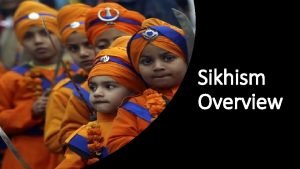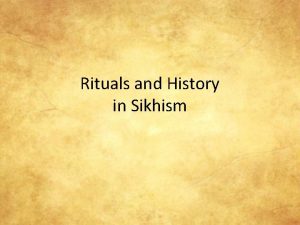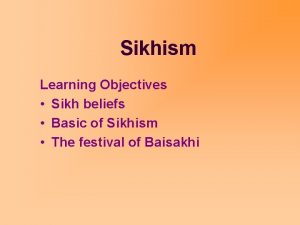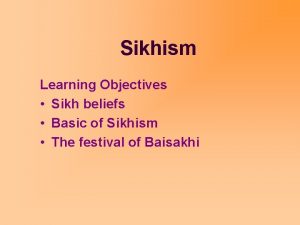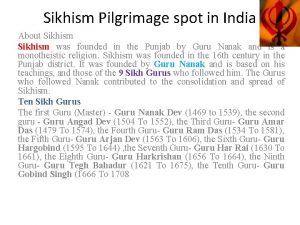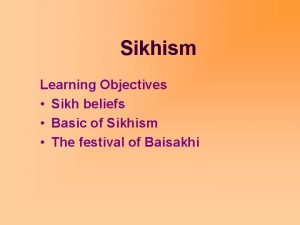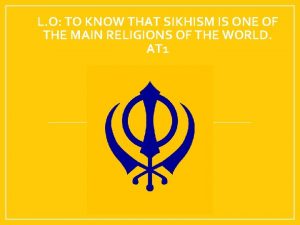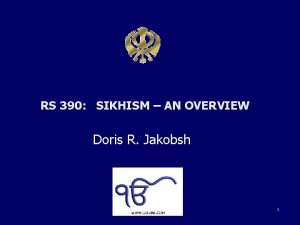Sikhism Overview Sikhism One of the newest and






































- Slides: 38

Sikhism Overview

Sikhism • One of the newest and smallest of the world’s religions. • Continually evolving sense of identity, often in relation to their Hindu neighbours.

Who is a Sikh? Any human being who faithfully believes in: • One immortal Being • Ten Gurus, from Guru Nanak to Guru Gobind Singh • The Guru Granth Sahib • The utterances and teachings of the ten Gurus and the baptism bequeathed by the tenth Guru and who does not own allegiance to any other religion.

The meaning of Guru • The Sikh is the learner. • The Guru is the teacher. Guru often refers to a spiritual leader

Guru Nanak was born in 1469 in a town that is now in Pakistan in the Punjab region

A separate faith? • Sikhism is a Hindu sampradaya (that is, movement led by a succession of gurus). • Sikhism is a ‘derived’ religion, drawn from the Hindu tradition. • Sikhism is a blend of the earlier religions of Hinduism and Islam. • Sikhism is a distinct revelation. • Sikhs are a ‘separate nation. ’

A sixth response: • Sikhism has evolved into a separate religion in terms of Sikhs’ self-definition, and because Sikhism has all the markers of a religion: Separate scripture and calendar, separate life-cycle rites, places of worship, and a sense of shared history. • At the same time, in common with other faiths, Sikhism cannot be fully understood in isolation from its religious, social, and historical context.

Influential factors: • The geographical region knows as the Punjab. • Religious traditions of Hinduism and Islam.

“There is neither Hindu nor Muslim”

God and the Goal of Life The Mul Mantar There is only One God His name is truth The Creator Without fear Without hate Timeless in form Beyond birth Self-existent - known by the grace of the Guru Ik Onkar

Additional beliefs about God: • God is without form or gender • Everyone has direct access to God • Everyone is equal before God • A good life is lived as part of a community, by living honestly and caring for others • Empty religious rituals and superstitions have no value

Common Misconceptions • God is seen in the same way as Hinduism

The Ten Gurus The Gurus

Common Misconceptions • Sikhs worship the Gurus

Guru Angad Dev (1504 -1552) – started to compile the Sikh Scriptures

Guru Amar Das (1479 -1574)- Sewa and Langar

Guru Ram Das (1554 -1581) – composed the Lavan, hymn used in Sikh weddings

Guru Arjan (1563 -1606) - built the Harmandir, put together the first Sikh holy book and became the first Sikh martyr.

Guru Hargobind (1595 -1644) - introduced the idea of miri and piri within Sikhism, story of Diwali

Guru Har Rai (1630 - 1661) – care for creation

Guru Har Krishnan (1656 -1664) - cared for those who were dying and Sikh beliefs about death

Guru Tegh Bahadur (1621 -1675) – second Sikh martyr

Guru Gobind Singh (16661708) – The Founding of the Khalsa (1699)

Common Misconceptions • Sikhs worship the Gurus

The 5 Ks

Khalsa initiation: Why did the Guru introduce them? • Adopting these common symbols would identify members of the Khalsa. • Because all members of the Khalsa wear the 5 K’s the members of the community are more strongly bound together. • Each K has a particular significance. The five K’s taken together symbolise that the Sikh who wears them has dedicated themselves to a life of devotion and submission to the Guru.

Common Misconceptions • All Sikhs are Khalsa Sikhs

The Guru Granth Sahib – the Final Guru

Common Misconceptions • Sikhs can’t own a copy of the Guru Granth Sahib

The Gurdwara

Common Misconceptions • The building is a Temple

The Langar

Common Misconceptions • Sikhs are vegetarian

Summing up: • • There is only one God. Living in God and community. God and the cycle of life The God of grace – attention move from self to God. They get this which is called mukti (liberation) through the grace of God. This is something God does to human beings, and not something that human beings can earn. Getting close to God – when a Sikh wants to see God, they look at the created world, and into their own heart and soul. The aim is to see the divine order that God has given to everything, and through it to understand the nature of God inside us God beyond us – seen in creation, the message has been shown to us by the Gurus in their lives and in their words. The message is set down in the teachings of scripture.

Summing up: • Living a good life in this world – Sikhism doesn’t ask people to turn away from ordinary life to get closer to God. In fact it demands that they use ordinary life as a way to get closer to God.

Three duties: • Nam Japna: Keeping God in mind at all times. • Kirt Karna: Earning an honest living – avoiding gambling, begging or working in the alcohol or tobacco industries. • Vand Chhakna – Literally – sharing one’s earnings with others. Giving to charity and caring for others.

The five vices: Sikhs try to avoid because these things are self-centred and build barriers against God in their lives. • Lust • Covetousness and greed • Attachment to things of this world • Anger • Pride If a person can overcome these vices they are on the road to liberation.

Any Questions?
 Newest part of the brain
Newest part of the brain Channel of distribution examples
Channel of distribution examples What is the oldest part of the brain
What is the oldest part of the brain Lighter comparative
Lighter comparative Maximo roadmap
Maximo roadmap Cabinet departments and independent agencies are created by
Cabinet departments and independent agencies are created by Night structure
Night structure One empire one god one emperor
One empire one god one emperor One one one little dogs run
One one one little dogs run One king one law one faith
One king one law one faith One god one empire one emperor
One god one empire one emperor One team one plan one goal
One team one plan one goal See one do one teach one
See one do one teach one See one, do one, teach one
See one, do one, teach one See one do one teach one
See one do one teach one One vision one identity one community
One vision one identity one community Graphic organizer with the aims of la liga filipina
Graphic organizer with the aims of la liga filipina Hình ảnh bộ gõ cơ thể búng tay
Hình ảnh bộ gõ cơ thể búng tay Slidetodoc
Slidetodoc Bổ thể
Bổ thể Tỉ lệ cơ thể trẻ em
Tỉ lệ cơ thể trẻ em Gấu đi như thế nào
Gấu đi như thế nào Tư thế worms-breton
Tư thế worms-breton Hát lên người ơi
Hát lên người ơi Kể tên các môn thể thao
Kể tên các môn thể thao Thế nào là hệ số cao nhất
Thế nào là hệ số cao nhất Các châu lục và đại dương trên thế giới
Các châu lục và đại dương trên thế giới Công thức tính thế năng
Công thức tính thế năng Trời xanh đây là của chúng ta thể thơ
Trời xanh đây là của chúng ta thể thơ Mật thư anh em như thể tay chân
Mật thư anh em như thể tay chân 101012 bằng
101012 bằng Phản ứng thế ankan
Phản ứng thế ankan Các châu lục và đại dương trên thế giới
Các châu lục và đại dương trên thế giới Thơ thất ngôn tứ tuyệt đường luật
Thơ thất ngôn tứ tuyệt đường luật Quá trình desamine hóa có thể tạo ra
Quá trình desamine hóa có thể tạo ra Một số thể thơ truyền thống
Một số thể thơ truyền thống Cái miệng nó xinh thế chỉ nói điều hay thôi
Cái miệng nó xinh thế chỉ nói điều hay thôi Vẽ hình chiếu vuông góc của vật thể sau
Vẽ hình chiếu vuông góc của vật thể sau Thế nào là sự mỏi cơ
Thế nào là sự mỏi cơ







































